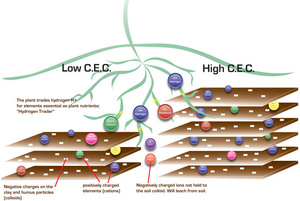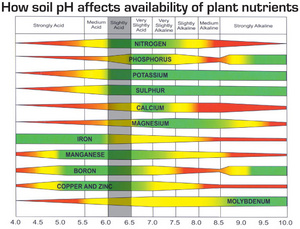Understanding the Science Behind Superior
Understanding the Science Behind Healthy Soil
Superior is the only fertiliser company that tests for all of the elements essential for healthy plants and thriving livestock. We sell solutions, not just products, with every mix leaving our factory custom blended to the soil test taken from the farm. Our approach is based on sound soil science principles, well documented in scientific literature and is backed by the knowledge shared by international consultants using it globally to grow a diverse range of crops. We have included this page as a reference for all interested current and potential customers.Understand Your Soil Cation Exchange Capacity
Superior analyses the Cation Exchange Capacity (C.E.C.) for each client, a unique variable that tells us how much fertiliser your soil can hold. For example, a soil with a C.E.C. of 12 will hold 100% more fertiliser than a soil with a C.E.C. of 6. The 'holding capacity' of your soil is driven by the amount of fine clay and humus particles in your soil, also known as soil 'colloids'. A colloid is simply anything microscopic suspended in a different medium. Soil colloids have negative charges which attract and hold positively charged elements e.g. calcium and magnesium. Since every soil varies, every soil need a custom fertiliser regime to maximise productivity. The thumbnail on left outlines cation exchange capacity.Soil pH is Essential for a Healthy Crop
pH is measured on a scale of 1 to 14, with 7 being neutral. The greater the concentration of hydrogen ions (H+), the lower the pH or more acidic your soil is (less than 7). A high pH (greater than 7) indicates a more alkaline soil with less hydrogen; a pH of 7 indicates a neutral soil.pH changes the availability of each nutrient for plant use. Soil pH is influenced by four major elements; Calcium (Ca), Magnesium (Mg), Potassium (K) and Sodium (Na). These elements need to be present in the correct amounts and proportions to give you a 'balanced pH' and achieve the ideal soil structure for plant roots to thrive. The 'ideal' soil has a balanced pH of around 6 - 6.5 and a soil structure that holds 25% air and 25% water; the optimum environment in which the soil microbiology can thrive. The thumbnail on right illustrates the availability of several important elements at various pH levels.
Soil Microbiology: Key for High Productivity
Our fertiliser programme is the key to creating the ideal environment for the soil biota.A fertiliser programme that does not consider the role and function of the soil biology can stifle a huge potential contribution to your productivity. For example, the overuse of nitrogen fertilisers can adversely affect the natural nitrogen cycle of the soil leading to a drop in the nitrogen (and other nutrients) provided naturally by microorganisms. Once the soil microbes have been 'switched off' in this way a greater and more frequent use of fertilisers will be required for crop response.Soil microbes also contribute to the soil structure and water-holding capacity of the soil and produce plant growth hormones and compounds that stimulate root growth, and protect the plant from pathogens.Creating the Ideal Soil Porosity with Custom Solid Fertiliser
Correcting the balance of calcium and magnesium is the key to creating the ideal soil porosity. While magnesium can pull a sandy soil together, calcium can condition a tightly held water-logged clay soil, opening up the soil creating more air space. Earthworms also play a part in aerating and conditioning the soil.Soil bacteria and fungi, in particular the mycorrhizal fungi that live in close association with plant root hairs, are largely responsible for the release of nutrients from soil and for breaking down fertilisers, making them into plant-available forms. Mycorrhizal fungi are especially important for releasing nutrients such as phosphorus which otherwise stays locked up in the soil. As well as aerating and conditioning soil, earthworms also have a role in shredding and decomposing plant matter; with digested soil (in worm casts) containing higher amounts of plant available N, P, K, Mg, Ca and Mo than the undigested soil.
If the soil structure is excellent, and the base saturation elements are in balance, the soil microbiology should flourish; resulting in up to 70% of crop nitrogen requirements coming from nitrogen fixation bacteria in legume root nodules and by soil microbes releasing nitrogen tied up in organic matter. This only leaves 30% of the nitrogen requirement to be supplied from another source. You can save on fertiliser expenses if the soil microbes are working for you.
By taking care of the soil - correcting the soil chemistry to influence the soil structure and pH, and avoiding overuse of nitrogen fertilisers you can enjoy all the benefits of a thriving soil microbiota.
The Role of Trace Elements in Healthy Soil
Trace elements are essential for vital biochemical functions in soil microbes, plants and animals. It is sometimes assumed that when all the major nutrients are present in the soil in the proper amounts, this makes the trace elements more available. However this is only true when all trace elements are present in the soil initially.Many soils can have a trace element deficiency which is harming the crop in some way, but is not yet a visible problem. This deficiency is often magnified in livestock; causing animal health to suffer. Once symptoms of these 'hidden deficiencies' show up it is often too late to reverse the problem. Reproductive irregularities or failure and increased infections are often the first symptoms of nutritional deficiencies in plants and animals. Often these can be linked to deficiencies in the soil.






